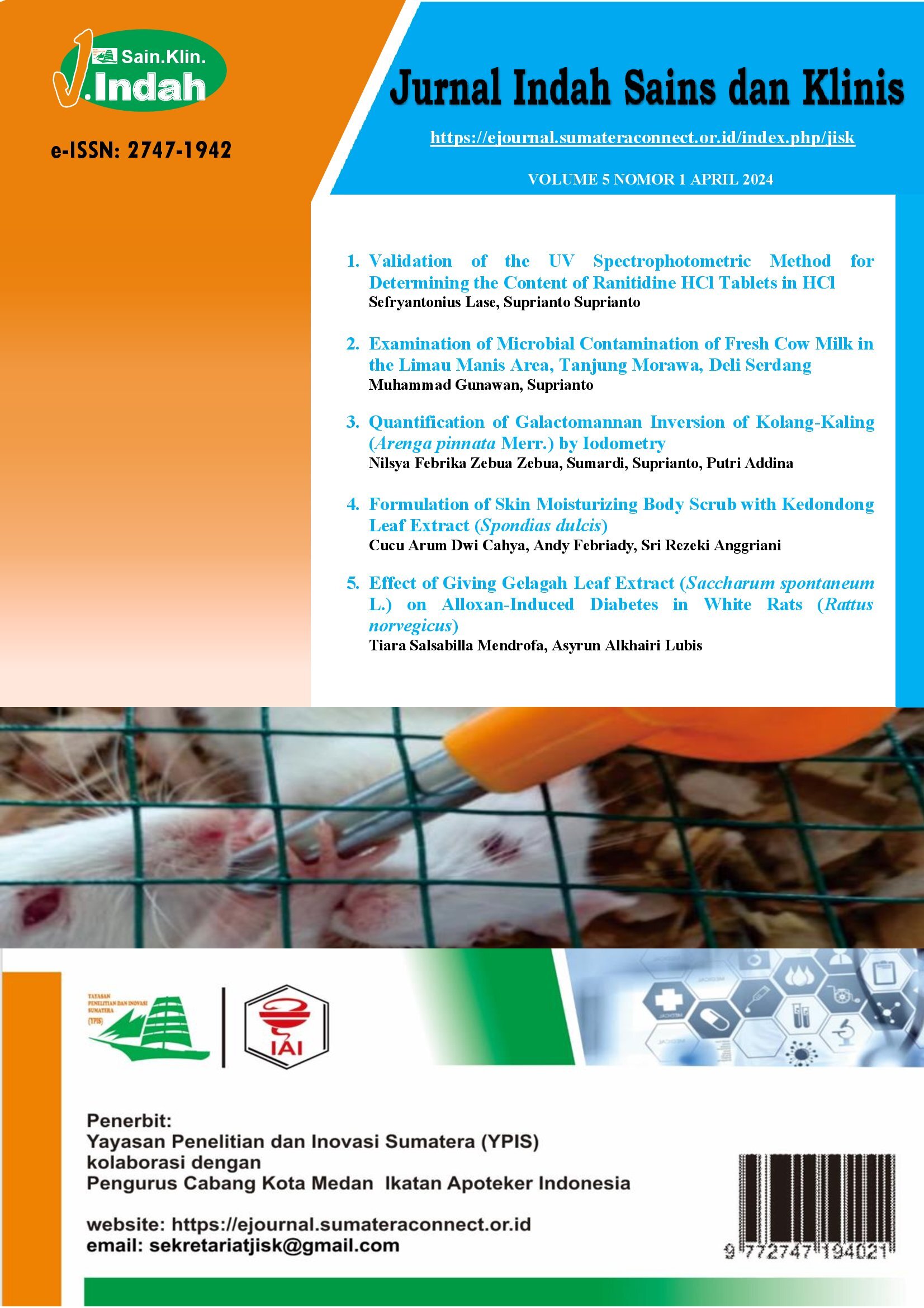Validation of the UV Spectrophotometric Method for Determining the Content of Ranitidine HCl Tablets in HCl
DOI:
https://doi.org/10.52622/jisk.v5i1.01Keywords:
Determination of levels, ranitidine HCl, spectrophotometry, validationAbstract
Introduction: Ranitidine HCl tablets are widely available in the market. Ensuring the proper levels of active ingredients is crucial for ensuring the quality of medications. Objective: To find a reliable method for measuring the levels of Ranitidine HCl tablets in acidic solvents that meet validation standards, and to explore valid methods using ultraviolet spectrophotometry in acidic solvents. Methods: UV spectrophotometry with a UV detector at maximum wavelength was used. Two solvents were employed: 0.10 N HCl and 0.15 N HCl. Method validation included tests for linearity, accuracy, repeatability, precision, and selectivity. Results: The maximum wavelengths detected for each solvent were 225 nm and 226 nm, respectively. Validation results indicate excellent linearity, accuracy, and precision within the ranges of 0.9984 - 0.9998; 99.6% - 100.7%; 0.427% - 0.861%; 0.518% - 0.952%. The selectivity test yielded positive outcomes. The average Ranitidine HCl tablet levels were 98.2% for PT. Hexpharm Jaya and 98.4% for PT. Mutifa Medan, meeting the standards of the Indonesian Pharmacopoeia Edition VI. Conclusion: The method using a 0.10 N solvent for determining Ranitidine HCl tablet levels meets validation requirements and is suitable for practical application.
Downloads
References
I. N. Alifah, “Analisis Interaksi Molekuler Asam Fenolik Kurma (Phoenix dactylifera L.) terhadap Reseptor Histamin H2 sebagai Model Penghambatan Sekresi Asam Lambung pada Gastritis.” Universitas Islam Negeri Maulana Malik Ibrahim, 2019.
Y. Syukri, “Teknologi Sediaan Obat dalam Bentuk Solid.” Universitas Islam Indonesia, 2018.
R. I. BPOM, “Pedoman Cara Pembuatan Obat yang Baik,” Jakarta Badan Pengawas Obat dan Makanan Republik Indones., 2018.
A. Rohman, Validasi dan Penjaminan Mutu Metode Analisis Kimia. Yogyakarta: Graha Ilmu, 2016.
W. S. Rahayu, P. I. Utami, and S. I. Fajar, “Penetapan Kadar Tablet Ranitidin Menggunakan Metode Spektrofotometri UV-Vis dengan Pelarut Metanol,” J. Farm. Indones., vol. 6, no. 03, 2016, doi: 10.30595/pji.v6i3.881.
L. C. Gois, W. G. de Borba, and J. G. Silva, “Determinação Condutométrica de Cloridratos em Comprimidos como Proposta de Atividade Experimental,” Rev. Virtual Química, vol. 11, no. 3, pp. 958–969, 2019, doi: 10.21577/1984-6835.20190066.
A. A. Elbashir and S. M. Merghani, “Spectrophotometric Determination of Ranitidine Hydrochloride (RNH) in Pharmaceutical Formulation Using 9-Fluorenylmethyl Fhloroformate (FMOC-Cl),” Asian J. Pharm. Res. Dev., vol. 6, no. 6, pp. 7–14, 2018, doi: 10.22270/ajprd.v6i6.454.
A. Mali, S. Kolekar, J. Franklin, and R. Bathe, “Simultaneous UV Spectrophotometric Methods for Estimation of Ranitidine and Domperidonein Bulk and Tablet Dosage Form,” Asian J. Pharm. Res., vol. 6, no. 2, pp. 100–106, 2016, doi: 10.5958/2231-5691.2016.00017.4.
O. A. El-Naem and C. M. El-Maraghy, “A Validated Liquid Chromatography-Tandem Mass Spectrometric Method for the Determination of Co-administered Ranitidine and Metronidazole in Plasma of Human Volunteers,” Anal. Methods, 2021, doi: 10.1039/d1ay00284h.
P. I. Utami, W. Utaminingrum, and N. A. Masyitoh, “Optimasi Metode Penetapan Ranitidin dalam Plasma Manusia secara in Vitro dengan Metode Spektrofometri Ultraviolet-Visibel,” J. Farm. Indones., vol. 6, no. 03, 2016, doi: 10.30595/pji.v6i3.880.
Departemen Kesehatan Republik Indonesia, Farmakope Indonesia, Edisi VI. Jakarta: Departemen Kesehatan Republik Indonesia, 2020.
S. Suprianto, “Optimization of Mobile Phase for Simultaneous Determination of Sweeteners, Preservatives and Dyes by UFLC,” 2023.
Suprianto, I. Hafiz, H. Faisal, and H. M. Harefa, “Validasi Metode Penentuan Tablet Allopurinol Menggunakan Spektrofotometri Ultraviolet dalam Larutan Asam,” J. Kim. Sains dan Apl., vol. 22, no. 2, pp. 29–37, 2019, doi: 10.14710/jksa.22.2.29-37.
Suprianto, D. Syamsul, and M. D. Harfiansyah, “Aplikasi Metode Penetapan Kadar Rutin Parasetamol PT. Kimia Farma, Tbk secara HPLC pada Sediaan Tablet Generik dan Bermerek di Medan,” J. Indah Sains dan Klin., vol. 2, no. 1, pp. 1–5, 2020, doi: 10.52622/jisk.v1i1.1.
S. Sharma, S. Goyal, and K. Chauhan, “A Review on Analytical Method Development and Validation,” Int. J. Appl. Pharm., vol. 10, no. 6, pp. 8–15, 2018.
[U. Beskan, S. T. Yildirim, and E. A. Yapar, “An Overview of Analytical Method Validation,” J. Pharm. Res, vol. 5, pp. 47–52, 2020.
D. Kapoor, R. B. Vyas, and D. Dadrwal, “An Overview of Analytical Instrument Qualification with Reference of Pharmaceutical Industry,” J. Drug Deliv. Ther., vol. 8, no. 5, pp. 99–103, 2018.
M. E. Swartz and I. S. Krull, Handbook of Analytical Validation. New York: CRC Press, 2012.
Downloads
Published
Issue
Section
License
Copyright (c) 2024 Jurnal Indah Sains dan Klinis

This work is licensed under a Creative Commons Attribution-NonCommercial-ShareAlike 4.0 International License.









 This work is licensed under a
This work is licensed under a 
